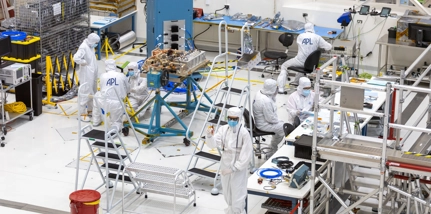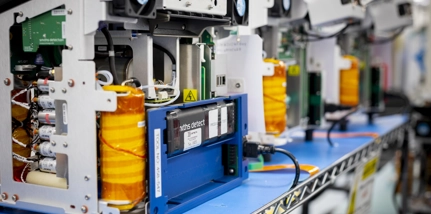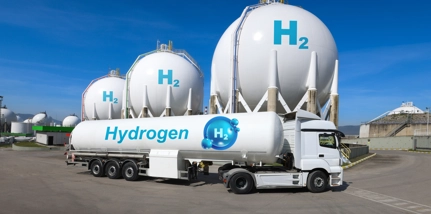
25 September 2024
Like a super-liner, turning a world so heavily dependent on fossil fuels to put it on course for net zero 2050 will take the collective thrust of many different strategic propellers.
One impactful – and immediately deliverable – strategy is carbon capture, which is supporting both the decarbonisation of existing industrial processes and the industrial-scale production of low-carbon fuels like blue hydrogen.

What is carbon capture?
A comprehensive strategy of ‘carbon capture’ has four stages - Capture, Transportation, Utilisation and Storage – collectively known as ‘CCUS’. Intelligently combined, they can prevent large volumes of carbon dioxide (CO2) from entering the earth’s atmosphere. Let’s take a closer look at how.
Capture
This phase begins by isolating and capturing the CO2 gas emitted while burning fossil fuels or during industrial processes such as the production of cement. There are various ingenious ways of doing this, including (most commonly) extracting it from the flue gas with help of a ‘bonding’ agent such as a nitrogen-based solution, using membranes to filter out CO2 from other gases, or selectively liquifying and freezing it.
Once captured, the ‘pure’ carbon dioxide is then typically compressed until liquified or, in many cases, into a denser gaseous form that flows like a fluid that’s known as a ‘supercritical’ CO2 (sCO2) - more on this later.
Transport
The compression process enables the captured CO2 to be more easily transported by pipeline or ship, for re-use or permanent storage.
Use
More accurately, ‘re-use’ is an integral part of a sustainable decarbonisation strategy because, while CO2 is harmful to our atmosphere, it is used in an extensive range of commercial and industrial applications. It’s involved throughout food production – from being a core ingredient in fertiliser to putting the fizz into drinks, chilling products in transit and extending the shelf life of many edible items. It is a common refrigerant, fire extinguisher and even has a variety of medical and surgical applications.
By harnessing CO2 ‘waste’ for use in carbon-dependent applications, particularly CO2 from hard-to-abate sectors, we can significantly reduce the overall CO2 footprint of industry.
Storage
The most well-established approach to storing CO2 is ‘geological sequestration’. This is a real feat of human ingenuity which involves injecting it deep underground into natural porous rock formations such as depleted oil or gas reserves or saline aquifers, so that it will remain safely and permanently stored.
Engineering a better future
At every stage of CCUS there is, of course, the potential for CO2 to leak into the atmosphere. But exceptional engineering is ensuring this doesn’t happen. And, having led the charge in mechanical seal innovation for over a century and helped reduce emissions from oil and gas refineries significantly over that time period, engineers from John Crane, a business of Smiths Group, are at the forefront of these efforts.
As a result, c.50% of all CCUS projects, including c.80% of the world's CO2 sequestration plants*, rely on our technology.
Two recent examples include our work to safely and efficiently seal the liquid CO2 processed at a major shipping terminal which is then transported on its carrier ships in central Europe and Norway. And in the US, we re-designed one of our dry gas seals to handle the intense rotational speed, pressure and heat of the supercritical compressor in the world’s first pilot sCO2 Power Generation Plant. This ground-breaking facility set out to prove the viability of sCO2 as a productive ‘working fluid’ (rather than waste) that can be harnessed to generate power. Its success has paved the way for a new generation of highly efficient and low-carbon power plants.
Full steam ahead
According to the International Energy Agency (IEA), there are some 45 commercial CCUS facilities in operation globally and another 700 new and retrofit CCUS projects in various stages of development. Combined, if they all complete on time, by 2030 they could be capturing around 435Mt of CO2 per year and offer a total storage capacity of up to c.615Mt annually.
That effort needs to at least double by 2030 to put us firmly on track for the net zero 2050 target. But with continuing success stories and emerging innovations building the momentum, CCUS has become one of the most practical, deliverable and powerful propellors accelerating us towards a more sustainable future.
*Carbon capture capacity numbers based on Global CCS 2022 report
Related insights

Searching for E.T.
Read our latest Engineering Explained insight on Smiths Interconnect's role in NASA’s Europa Clipper - to search for life on the fourth largest of Jupiter’s 95 moons.
Find out more

Integrating a sustainable ethos into our products
Find out more

How our engineers are helping hydrogen to become a source of new energy
Read our latest Engineering Explained insight piece on how our engineers are helping hydrogen to become a safe, secure and profitable source of new energy
Find out more






